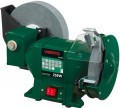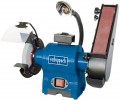Machine
Type, in other words, the general purpose of the machine.
—
Sharpening. In accordance with the name, the main purpose of such units is to sharpen the cutting edges of various tools — from knives, chisels, etc. to saw blades and chains of mechanical saws (for more details, see "Sharpening"). Such processing is carried out due to the rotation of the abrasive disc. The traditional, familiar to many grinding machine (grindstone) has two discs on the sides of the casing with the engine; however, there are often models that differ in design (especially among specialized units, for example, for sharpening chains).
—
Grinding. Grinding in the general sense is called all machines for grinding — semi-finishing and finishing of various surfaces. However, only aggregates that are not related to surface grinding are included in this category (for the latter, see below). Such machines can use different types of work items. One of the most popular options is a sanding belt mounted on two pulleys and moving due to their rotation; such a tape can be located both horizontally and vertically (“on the edge”). Another common type of work item is a disk on which sanding paper is attached. At the same time, unlike a grinding machine, the role of the working surface is played not by the edge of the disk, but by the round surface itself; this, in particular, allows you to vary the intensity of processing by moving
...the workpiece closer to the centre of the circle (where the speed of movement is lower) or vice versa. There are also combined models — for two rotation modules (see below), combining both types of work items. A separate category are spindle grinders working with sleeves (see "Working element").
— Grinding and grinding. Models that combine the capabilities of grinding and grinding machines (see above). Usually, such a unit is similar to a classic grindstone with two rotation modules, in which a sanding belt or brush is installed instead of one of the discs. Thus, both sharpening and grinding can be performed on one machine. The downside of this versatility is that both in terms of grinding and grinding capabilities, such machines are inferior to specialized models. Therefore, this option is designed mainly for situations where versatility is more important than advanced functionality.
— Grinding and polishing. Machines designed both for sharpening tools and for polishing — fine finishing of the surface of the material being processed, making it smooth and shiny. Polishing can be carried out according to the same principle as sharpening — using a rotating disk; therefore, most often machines with a polishing function are positioned as combined grinding and polishing machines. Such units are often equipped with an engraver on a flexible shaft (see below). Note that they are usually somewhat smaller than "pure" grinders, use smaller discs and are less suitable for rough work.
— Polishing. This type of machine tool is similar in design to the grinding and polishing machines described above; the key difference is that the polishers only use smooth polishing pads, and are not designed for abrasive sharpening tips (even if it is technically possible to install such a sharpening tip). Such units are less versatile than grinding and polishing units, and they do not have key advantages over them; therefore, purely polishing machines have not received much distribution.
— Surface grinding. A type of grinding machine, designed primarily for the processing of flat surfaces, including conjugated. Such aggregates are fundamentally different from the "ordinary" grinding (see above) in design and mode of operation. They use a working element in the form of an abrasive disk fixed above the desktop; this table, in turn, is fixed on a massive frame, and the workpiece on it is installed in a special fixture and moves under a rotating disk during processing. Surface grinders make it easy to process large surfaces, but they are very massive, bulky and expensive, and therefore are considered professional (and even industrial) class equipment.Location of rotation modules
Mutual arrangement of rotation modules in models with more than one such modules (see above).
— Aligned. Rotation modules located on the same axis — usually, on different sides of the casing with the engine. The most simple and at the same time reliable option used in most modern machines.
— At a right angle. In such machines (usually they belong to grinding machines, see “Machine”), the axis of one of the rotation modules is located as in the coaxial ones described above, and the second module is rotated 90 ° — thus, the plane of rotation of the disk is in front (or behind) from the body. This option allows you to use larger discs than in coaxial models, as well as to equip them with wet baths without much difficulty (see below). On the other hand, the arrangement at an angle complicates and increases the cost of the design.
Work part
The type of work item (nozzle) for which the machine is normally designed.
—
Disk. In this case, we are talking about a tool that is designed only for disks and does not initially provide the installation of other work items (although theoretically, many grinding machines allow replacing a disk with a brush, see below). This option is found in almost all varieties (see "Machine"), with the exception of grinding and grinding — in them, the disc is necessarily combined with a tape or brush. Also note that grinding discs are different from grinding and polishing discs; see "Machine — Grinding" for details.
—
Ribbon. Machines designed only for a belt are grinding machines — in other varieties, a similar work item is not used.
— Disk/tape. Machines that combine in the design of seats for the disk and for the tape. This option is found in grinding and grinding machines, while the features of the discs used for these varieties differ; see "Machine" for details.
— Disc / brush. Tools designed to use both a disc and a brush; usually, they refer to grinding and grinding machines — a stiff brush is used for cleaning and pre-treatment of the sharpened tool (for example, removing rust or hard dirt that cannot be washed off with water). Note that this option is indicated only for models that are initially equipped with brushes and/or equipped with specialized seats for them; with cer
...tain tricks, the brush can also be installed on a classic grinder, originally designed only for discs, but this is still not recommended.
— Brush. Units that use only brushes during operation are usually metal. Such work items easily cope with rust, dried paint and various contaminants, but are not suitable for more or less accurate grinding, let alone sharpening. Accordingly, this option is typical for specialized grinding machines that are designed for primary processing of various surfaces before finer processing. For other tasks, "pure brush" units are not suitable, and the possibility of working with a brush can also be provided in a machine with a combined working element (see "Disc / brush" above). Therefore, there are relatively few such models.
— Sleeve. A working element used in a specialized variety of grinding machines — the so-called spindle. Such units are designed for cleaning curved surfaces, including internal — holes, figured recesses, etc. The sleeve is a cylinder with an abrasive surface, put on the engine axis (spindle). These nozzles can have different diameters. In turn, the spindle is located vertically in the centre of a flat desktop, which plays the role of a support, and during operation it not only rotates, but also oscillates up and down, which has a positive effect on the quality of grinding and ensures uniform wear of the sleeve. In many models, the desktop can tilt, which further expands the capabilities of the deviceDisc speed
The nominal speed of rotation of the disk for dry processing (see above), provided by the machine; for models with adjustable rotation (see below), the maximum rotation speed.
For the same disc diameter and material, a higher speed provides more intensive processing, and a slower rotation contributes to accuracy and precision. In addition, optimal speeds depend on the composition of the disc and the material being processed; detailed recommendations with specific figures for a particular situation can be found in special sources.
A separate category is grinding machines with disk-shaped working elements: in such units, the actual speed of movement of the disk surface relative to the workpiece depends on how close the contact point is to the centre of the disk.
Belt length
The length of the belt used in a machine with grinding functions (see "Machine"), more precisely, the total length of the entire belt ring installed on the machine.
This information is necessary to select the correct sanding belts — matching in length is essential for the proper installation and operation of the attachment. In this case, the working length, usually, is more than 2 times less than the total, and to determine it, it is worth focus on the dimensions of the desktop (see below).
Belt width
Belt width for which the machine with grinding functions is designed (see "Machine"). The value of this parameter for compatibility with the tape can be different: in some models, the tape must exactly match the standard width, in others narrower tapes are allowed. From an application point of view, the larger width allows larger workpieces to be handled.
Belt rotation speed
The nominal belt speed provided by the machine with the grinding function (see "Machine"). Other things being equal, a higher speed is useful for ensuring intensity and productivity, a lower speed allows for more precise control of the process. Detailed recommendations with specific figures for a particular situation can be found in special sources.
Wet processing
Wet processing involves the supply of water or other liquid to the working element during operation. This mode is found only in models with grinding functions (see "Machine"). The disc rotates at a relatively low speed. Due to the combination of water cooling and low speed, the risk of overheating and spoiling the machined tool is reduced to almost zero; in some cases (for example, when sharpening blades made of carbon tool steel), this is especially important. In addition, “wet” sharpening is more accurate, the process waste does not scatter around so much. On the other hand, the low rotation speed of the disk imposes its own limitations on the use of this method, and the machines turn out to be heavier, bulkier and more expensive than completely “dry” counterparts.
Disc diameter
Regular diameter of the disk (see "Working element") used by the machine for wet processing. Unlike dry sharpening, in this case, this parameter most often describes not the maximum, but the optimal diameter of the nozzle for a given machine: a disc that is too small may simply not reach the liquid poured into the working bath.
If the machine is purchased for infrequent everyday use, this parameter can be ignored; but for large volumes of work it is recommended to use larger discs.

